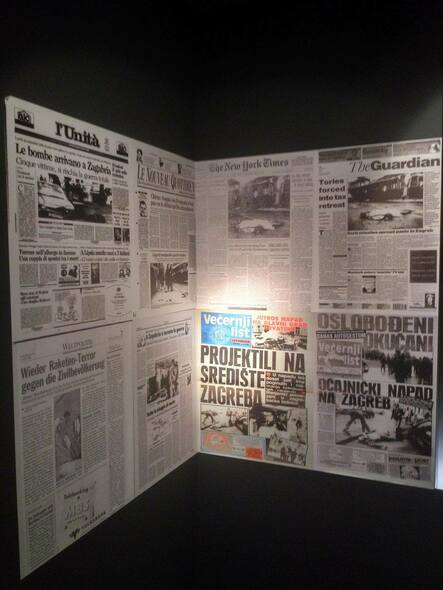Hidden in the Petriceva Ulica in the center of Zagreb the “Memorijalni centar raketiranja Zagreba” (Memory Center of the Shelling of Zagreb in 1991 and 1995) is located, which is a collection of the City museum of Zagreb. The Museum is dedicated to the events of Yugoslav Air Force strike on Banski dvori and artillery attacks on Zagreb conducted by Serbian armed forces in Republika Srpska Krajina on the 2nd and 3rd May 1995. The last event was characterized by the ICTY as a war crime and a crime against humanity. Milan Martić, one of the Croatian Serb leaders from the early 90’s was convicted for ordering these attacks.
A small plaque on the house in Petrićeva Street refers to the exhibition inside. The door in the first floor was locked so we had to ring – nobody answered, we rang again. Finally, a women opened the door and welcomed us very friendly. We explained who we are, that we are from the YIHR and immediately she was guiding us around the exhibition. We entered the first room – she was telling us about the Serb air strike against the ‘Banski dvori’ in Zagreb in 1991. We could see the damaged sofa from the destroyed room. It wasn’t just standing on the floor – it has it´s stage surrounded by bright light – pathetic. We should see how elegant the room was furnished, and the Serbs destroyed it. But luckily they did not succeed in killing the president Tuđman, the guide said, what was their goal to destabilize Croatia.
We were looking around. The room was filled with soft light and big photographs of the shelling of the upper town of Zagreb. Buildings were burning and destroyed. In the middle we could find a table with some electronic books showing the order of events in October 1991.The Next rooms exhibited different newspapers from different countries which had all nearly the same headlines (“Serb terror against civilians”). Furthermore, grenades were shown which were used by the Serb forces, even they were forbidden by the Geneve Conventions, smashed glass, photographs and names of the victims and artifacts which either belonged to injured people, like the ballet shoes of the prima ballerina who was injured by the shelling of the National theater of Zagreb or symbolize the attack on the children’s hospital. Therefore, a Teddy bear is sitting lonely in a showcase. The Museum in general offers many symbols which shall underscore the scare of the events.
By observing only this museum’s narrative, the visitor can easily forget that the so called “Homeland War” had more than this one perspective,and this is the problem in general when an exhibition is too much aligned on a certain past event like the shelling of Zagreb. The whole context and the different perspectives of the war during the 1990’s gets lost – only the narrative remains that Croatia was forced into a war, fought against it and finally won. This is what is depicted in the last room of the memorial center. A short movie shows Zagreb today as a living and young city. The damages of the shelling are cleared of, lots of tourist come every year – everything is fine, a happy ending for Zagreb and whole of Croatia.
This Museum honors the innocent victims of the shelling of Zagreb, and tells a story about horrible war crimes and its consequences. It was surprising to see how the story is presented trough modern technology with very considerate guidance. But the museum is also an example of a memory culture which reduces the past on certain events, and it is using simplistic ethnic dichotomy of Serbian perpetrators and Croatian victims. In some places in the museum it can be seen that the term Serbs or Serbian is used carelessly, like it is blaming the whole ethnicity for the war crimes. The Museum should instead use the names of the exact military divisions or individuals who ordered and conducted the attack, so the visitors should not be confused or mislead towards wrong conclusions about the events.
This museum is one of many in Croatia which is dedicated to the war crimes committed by the Military of Serbian Krajina or the Yugoslav People’s Army and victims of these crimes. But dealing with the past shouldn’t be that easy. What Croatia needs isn’t another museum which deals with the suffering of Croatia during the war trough representation of single events in the 90’s but rather a place where the visitors can inform themselves about every aspect of the war, even the aspects of war crimes committed by Croatia. It also needs a museum which presents and commemorates all civilian victims, regardless of their ethnicity. But the establishment of a museum like this seems to be faraway.
Blog by Katja Lorenz & Nikola Puharić


